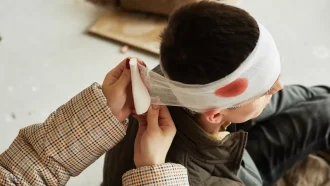
What Is the Mind and Body Connection?
Have you ever thought that your brain plays a much larger part in your wellness than just your mental health? Medical professionals would agree. The mind-body connection is the feedback loop between your thoughts and your feelings. “Feeling” here doesn’t mean the emotions you feel, but rather your physical condition. When you feel a certain way mentally, this usually has a physical component evident to any observer. For example, when you are nervous, your stomach gets tied in knots or feels like there are butterflies inside of it. Your thoughts can shape how your body responds and vice versa. If you adjust your body to seem more confident, your brain will translate that into thinking more confidently.
Most people treat their minds and their bodies as two separate entities when they are, in fact, tied together. What one does affects the other. Yet we as a species are only now figuring out how vital this mind-body connection can be. The chemistry and biology of the brain can affect the body’s physical responses to massive degrees. When we first learn about biology and biochemistry in school, we do so in isolation. However, it’s only when we consider the interlinked relationship between the endocrine, immune, peripheral, and nervous systems together as a coherent machine do we start to understand how the brain can influence our physical well-being.
Free Mental Health Assessment
The Biology of Mind And Body Connections
Table of Contents
Despite the amount of research that has gone into it, we still don’t fully understand how the mind-body connection works. The mind is still mostly a mystery, but we learn new things with each day. The brain is the physical manifestation of our thought processes. The neurons and axons in the brain are responsible for processing thought and creating consciousness. Yet the brain itself is only the physical part of the process. The abstract portion of it is the mind. And it’s in the mind that a lot of our actual thinking occurs. Beliefs, foundational morals, and even attitudes and emotions form the core of what our mind does for us. The brain might do the heavy lifting, but the mind contextualizes what we consider.
In the brain and throughout the body, messages are sent from one part of the body to another. These messages are transmitted through the nervous system by nerves, which use a set of chemicals to cross small gaps in the nervous tissue. These chemicals are called neurotransmitters and play a crucial part in helping us feel things. From a tickle to the pain of a burn, every sensation comes from these neurotransmitters. Research has pinpointed neural networks that link the body’s biological responses to thoughts processes from the brain. The hormonal (endocrine) system is responsible for this part of the brain-body link. For example, when a dangerous situation presents itself, the body leaps into action by flooding the bloodstream with adrenaline to reduce pain response and give the body a burst of power and strength.
Using Psychosomatic Illness as Evidence Of Mind-Body Connection
A psychosomatic illness is a term used to describe an illness that doesn’t seem to have any physical cause. The condition may present physical symptoms but might not have any reason for those symptoms existing. Psychosomatic illnesses usually bring about pain and other symptoms that might lead a patient to seek out a doctor’s advice. Yet, no matter what tests the doctor runs, there’s no reason for the person’s illness based on what conventional medicine understands. Today, we know that psychosomatic diseases are based on the mind-body connection. In the past, many doctors would assume that these illnesses result from a person’s disturbed mental state. It’s not uncommon to find doctors referring these patients to mental health facilities.
We have a better grasp of the link between stress and psychosomatic illnesses in the modern world. However, there is still a pervasive social aspect of psychosomatic illnesses that leaves patients wary of seeking help. Additional studies have also shown that real physical debilitation may result from increased stress and emotional anxiety in a person’s mind. A person’s immunity drops as white blood cell production drops during stressful periods. Psychosomatic illnesses prove that stress significantly impacts a person’s well-being. A person’s mind can lead to a person becoming ill, even if there’s no physical reason for that illness.
How To Improve the Mind And Body Connection?
The mind-body connection is real, but what does this information mean for you as a person? Knowing the link between wellness and the mind-body link will give a person the ability to control the way their body interacts with their brain. There are several methods of bridging the mind-body connection consciously. One of the most common methods of doing so is by performing yoga. Yoga allows the body to create more of the neurotransmitter GABA, which aids in relaxing the mind. Higher GABA levels usually translate into the person feeling happier and more fulfilled with their life. People who perform yoga often tend to show much higher rates of GABA than people who don’t.
One method that works wonders is cognitive-behavioral therapy (CBT). CBT has shown a lot of promise as a tool for helping individuals with substance abuse. It works by teaching a person to spot the negative thoughts accompanying their negative actions. Once a person can figure out those thoughts, they can potentially avoid leading to situations where they feel they have no choices. In managing one’s mind-body link, a person can use CBT to figure out what thoughts are preying on their mind and causing stress. They can then organize those thoughts and the stress associated with them. The goal of stress management is to keep from getting sick.
What Are Some Mind and Body Therapy Types?

A broad swathe of mind-body therapies allows people to access this link and reduce their stress. Among the most common ones that patients tend to use are:
- Patient support groups: Discussing a topic in a group makes it easier to understand. Others might learn something about their mind-body link and may be able to share it.
- Cognitive Behavioral Therapy: CBT helps patients by allowing them to control their thought processes directly.
- Meditation and Prayer: Both of these perform the same action, reducing stress and allowing for more mindfulness in one’s daily life.
- Creative Arts: Many professionals use this as a way to blow off some steam and relax.
- Yoga: As mentioned before, yoga practitioners tend to have better GABA levels which make for a more relaxed feeling overall.
- Biofeedback: This method uses physical connectors to measure a person’s response to their brain activity in real-time.
- Martial Arts: Tai Chi and Qigong specifically allow for breathing exercises that serve to relax a person’s mind and body.
- Relaxation: Taking a trip or taking a few days off of a job can benefit from relaxing a person and having them ready to tackle things anew.
Mind And Body Disconnections in Substance Use Disorders
While the rest of medicine is rediscovering the mind-body connection, it’s not a new thing for individuals who have been involved in recovery. Over the years, the link between mind and body has played a critical part in understanding how recovery from substance use disorder works. Many of the methods used in the past were not scientifically backed and, as such, were more trial-and-error than anything else. However, thanks to the renaissance of the mind-body connection in therapy, there are now a lot of new approaches to helping individuals use the mind-body connection to overcome their addiction.
Immediate Placement for Mental Health Treatment
Mindfulness-Based Relapse Prevention (MBRP) is a technique similar to CBT for substance abuse that helps a person mitigate the onset of relapse. It allows a person to note the triggers that could lead to their emotional deterioration (which, with time, becomes a physical relapse). Additionally, it will enable a patient to get more comfortable dealing with unpleasant situations. Since the real world is filled with these unpleasant situations, there’s no telling when this technique will come in handy. Instead of having these negative situations lead to massive fallout and potential relapse, MBRP can give patients the tools to withstand the pressure.
Cultivating Both Body and Mental Health in Residential Rehab
Residential rehab is one of the best places to institute mind-body techniques to control and overcome substance use disorder. In a residential facility, the patients can focus on their recovery without any distractions from outside; These facilities also limit the availability of substances that could further lead to addiction. Massage techniques can be used to help with the symptoms of withdrawal. Some of these withdrawal processes lead to severe muscle cramps that can be alleviated by massage therapy. Mindfulness has the effect of reducing cravings and helping the patient understand how their actions impact those around them negatively. Acupuncture, alongside opioid medication, can help to lower the feeling of craving and prevent relapse.
Reconnect With Mind and Body Health at Emerald Isle Recovery
Emerald Isle Health & Recovery believes in healing the whole person. Mind-body techniques have proven efficacy at some level, and we believe that a patient should be able to experience the latest developments in this realm of study. Our professional staff deal with conventional treatment alongside our alternative therapies so that patients can get the best of all worlds.
Our approach to healing has always been to deal with each person as an individual, so we offer unique plans to each of our clients. We provide a place where recovering persons can focus on their well-being and mental health without worries. Give us a call today to learn more about how Emerald Isle can help you on the road to recovery.








